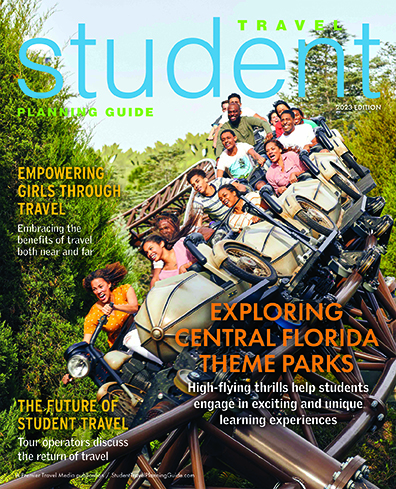The Past Comes Alive at Colonial Williamsburg
Imagine being completely immersed in an entirely different time and place: traveling back to the dawn of America at Colonial Williamsburg, located in the former capital of Virginia, where dreams of American independence and freedom took root.
At the world’s largest living history museum, students can learn pioneer trades from artisans, tend colonial gardens, discover what the culture was all about, and meet the men and women who transformed a colony into a country. At Colonial Williamsburg, it’s more than a museum; it’s an opportunity to go back to where it all began. Below is a peek at seven of the museum’s most popular attractions.
1. Looks like a Carriage, Works like a Time Machine

18th-century horse-drawn carriage at Colonial Williamsburg.
Leave modern-day traffic behind and take a leisurely ride through the historic district in an 18th-century horse-drawn carriage. In carriages that seat up top nine, student groups can surround themselves with the sights and sounds of this unique city while catching a break from the bustle of the outside world.
Carriage rides tend to sell out quickly, so student groups are encouraged to make reservations as early in the day as possible.Tickets can be purchased at the Lumber House Ticket Office, William Pitt Store or online here.
2. Stomp the Clay

Students can get their feet dirty and stomp clay.
Throughout the summer, local brick makers mold and dry thousands of bricks. You can even pitch in as an apprentice to stomp water into the clay with your bare feet. In the fall, visitors can watch as those bricks are baked in a massive wood-fired oven. Students should also keep an eye out for masons using these bricks in projects around town.
The brickyard, open daily from 9 a.m. to 5 p.m., is wheelchair accessible and requires an admission ticket to enter.
3. The Original DIY

Student groups will get a taste of what it was like to make furniture in the past.
Engage with skilled cabinetmakers and joiners as they fashion windows, cupboards and ornate pieces of furniture for the town’s homes and buildings. Watch as carpenters use hammers, planers, saws and intricate carving tools to create their detailed designs.
Apprentice cabinetmakers studied for several years under their masters to perfect the art of furniture making. Students can discover how these cabinetmakers learned the necessary mechanical genius and innovative designs while observing the construction of tables, chairs, chests and desks.
The cabinetmaker workshop is open Monday through Friday from 9 a.m. to 5 p.m. and Sundays during the same hours. It is closed on Saturdays.
4. Farm to Table

Gardens using 18th-century techniques give a look into culinary’s past.
Get your hands dirty in the colonial gardens, where you can meet a gardener using planting and harvesting tools common in the 18th century. After working up an appetite, visit one of four historic taverns or stop into Raleigh Tavern Bakery for a sweet treat.
Filled with vegetables and perfumed by heirloom roses and herbs, the colonial gardens feature historians demonstrating 18th-century techniques, handling specialty tools and educating visitors about the vegetables that were grown for food and flowers that decorated the surrounding landscapes.
5. 18th-Century Social Media

The printing press teaches students how publications were built in the past.
In an age before radio, TV and the internet, the written word was the primary means of communication and entertainment. Experience the historical printing presses and meet a bookbinder to learn the tricks of this intricate trade.
Students can watch and learn as printers use reproduction printing presses and set type to manufacture colonial newspapers, pamphlets, books and political notices. The printing press exhibit is open Monday through Thursday and on Sundays from 9 a.m. to 5 p.m.
6. Vote for Independence

The capitol building holds various presentations for student groups.
Walk the halls where the colony’s representatives struggled with the British governor over the meaning of American liberty. Rediscover the founding principles of our government and the rights and responsibilities of citizens in a new republic.
On various dates each month, students can witness Cry Witch, an interactive performance where spectators have the opportunity to question witnesses, weigh evidence and cast a vote for the guilt or innocence of Grace Sherwood, otherwise known as the “Virginia Witch.” Planners should be aware that this interactive activity is not suitable for young children due to subject matter and intense emotion.
Students can discover the meaning of America’s revolution and royal government at the Capitol building from 9 a.m. to 5 p.m. daily.
7. Meet our Nation Builders
Get to know the men and women who shaped the very fabric of America. Speak with a Nation Builder and learn their contribution to the building of our nation as you experience their world.
An elite crew of interpreters, these Nation Builders portray real historic figures who made significant contributions to the history of the nation, including George Washington, Edith Cumbo, James Madison, Thomas Jefferson, Ann Wager and many more.
Students can engage with Nation Builders, experience their world and learn how each individual’s legacy has continued to inspire and influence American principles. Planners can check out Colonial Williamsburg’s interactive calendar to see when specific Nation Builders will be featured each month.






